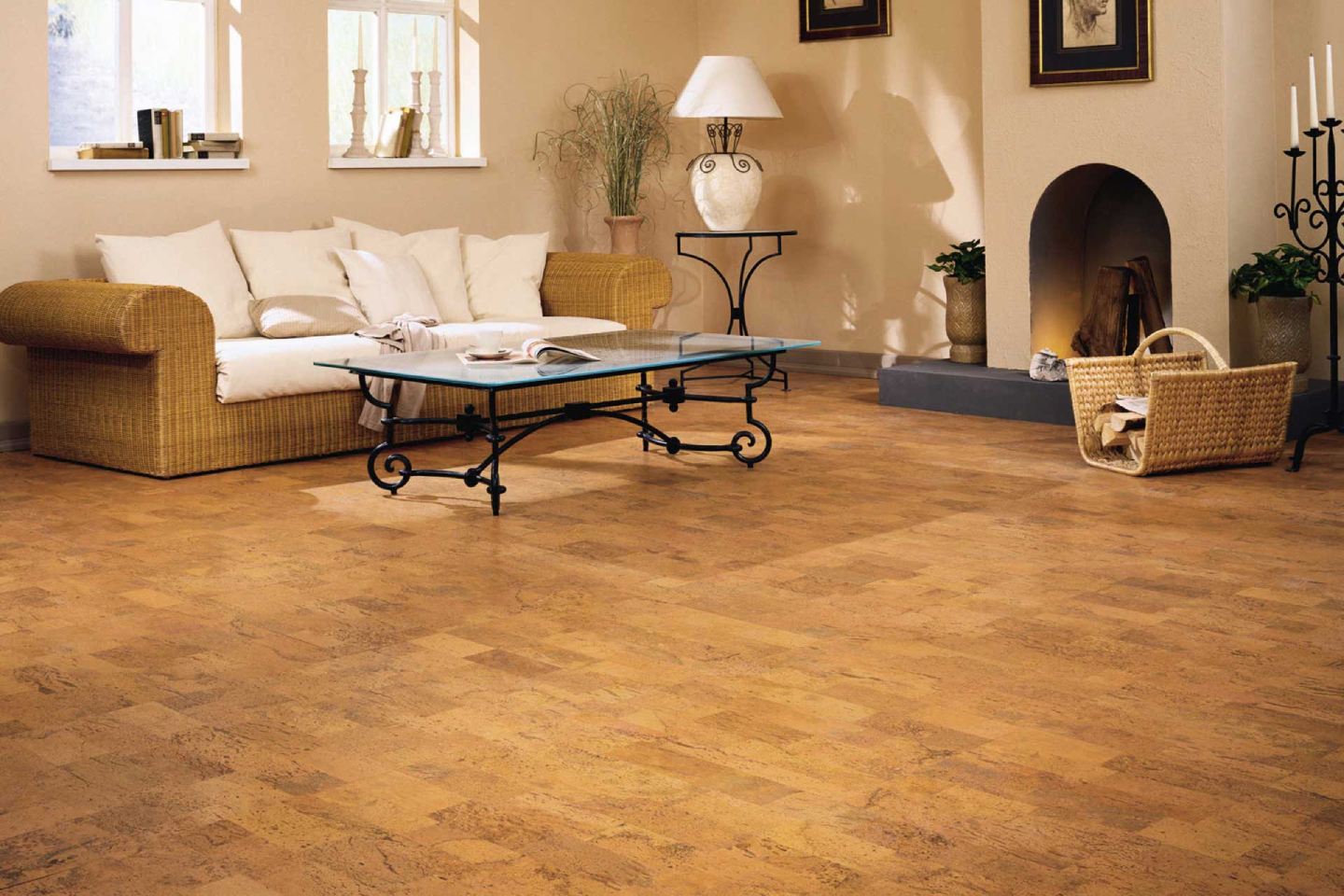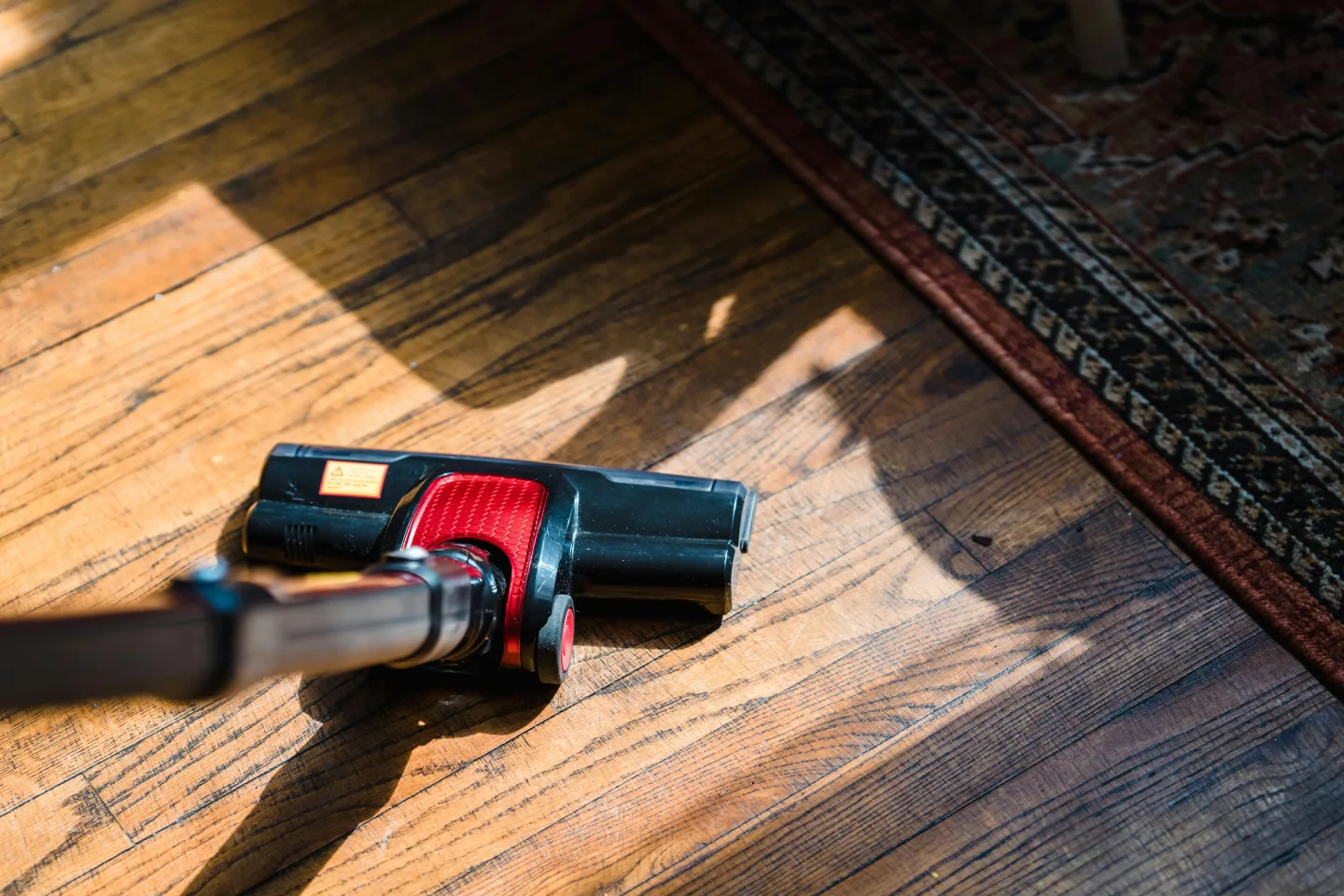2 Different Types of Cork Flooring – Pros and Cons

What is Cork Flooring?
You may ask why cork flooring. Just take a look at its unique options, then give it a second thought! The reason for the growing popularity of cork flooring is that it feels natural and soft when walking on and elevates the look of your house. It is made from cork oak trees by compressing and forming sheets attached to one another using resins. So, the 6-layered surface is completely natural and eco-friendly and can be easily replenished or recycled. Cork floorings are either glued down or clicked together. Then, they are finished by sealing as the second barrier on the surface to protect it against moisture and damage.
They have a wide variety of uses ranging from office workplaces to houses and bathrooms. Depending on the design of your house, you can choose from classic designs such as oaks and pines to more modern and softer ones such as vinyl and cork-in wood. The traditional ones give you a warm, natural look suitable for workplaces and meeting areas, whereas modern cork floorings resemble hardwood and marble flooring, giving you a sense of luxury. They are available in different finishes and colors, including cool or warm shades.
Cork Flooring Types
There are two main types of these floors: glue-down and click-together. Having their unique features, the price is the same, but they are installed differently.
If you want tiled planks and a classic look, then choose glue-down ones. Being durable and eco-friendly, they are pressed into blocks and sliced into sheets. Later, they are cut into tiles that are either homogeneous or heterogeneous. The latter ones have an extra layer of stained veneer. Available in a variety of shapes, sizes, and colors, they are prefinished with polyurethane. Remember that they require a smooth subfloor so that moisture does not cause damage.
On the other hand, click-together (or floating) cork floors feature a clicking system so that they do not attach to the subfloor. They are installed on an existing floor since they feature a rigid middle layer. To do so, they have an underlying foam to help soften the two floors. The difference in installation is that you’ll need a hammer and a tapping block to click the planks together. Its unique features and designs reduce installation time and costs.
Cork Flooring Design
Forget about the cork flooring design you remember from the 70s. Nowadays, new methods and technologies are being used to create different styles and patterns, and cork flooring has had a huge comeback now as a water-resistant, high-quality, eco-friendly material. You can see cork flooring design in recent years in almost all locations of the house, even bathrooms. And since they come in 2 types, including planks and tiles, buyers have much more freedom and, therefore, love cork flooring.
Cork Flooring Pros & Cons
PROS

Comfort: Cork flooring is very soft when walking on. They best suit houses with small children or people prone to falling and slipping. They are also high-quality and light to carry and install. But the most important factor is that it gives a unique, beautiful look to your house.
Eco-friendly: Since it is made from cork oak trees, the materials used are natural and eco-friendly. If damaged, you can replace them by triggering pads on the surface. The cork regenerates itself since the structure is breathable, thus being recyclable.
Proofing Options: Cork flooring features great thermal and acoustic characteristics. Besides being hypo-allergenic and anti-microbial, they are moisture resistant. On the other hand, more recent cork planks are among the waterproof flooring options; they were made widely available in 2019.
Resistant to Insects: Cork has a substance that can repel insects, acting exactly like chemical repellents without the danger of being affected by chemical substances. They can also repel molds, bugs, and even fire.
Affordable: Five to ten dollars per square foot, cork flooring is the affordable remedy you are looking for.
Maintenance: It is easy to maintain. Besides being sustainable, it is also an ideal option for people who have difficulty with joints since they are soft on joints.
Replacement: If damaged, affected pieces can be easily removed and replaced by newer ones. The older pads can be recycled as well.
CONS

Durability: Cork is not as durable as other flooring material types. If you move the furniture regularly or if you have small children or pets running around the house, it can be easily scratched. Although cork is not durable, it can be warranted for a long lifetime if you take enough care of its underlying characteristics.
Sealing: Sealing is required to protect the cork from any damage, such as sunlight or water. To avoid that, you can add a special varnish or paint to protect the seal. Due to the complex look of the cork, it is not easy to tell when the time to recoat it is, leading to a shorter lifespan. So, remember to recoat the surface every 3 to 7 years based on your daily usage of it.
Fading: Cork is not suitable for open spaces or rooms with direct sunlight exposure because it lightens the cork and might change its color due to ultraviolet light. You have to protect it using UV protection coats.
Cork Flooring Installation & Maintenance

Installing cork flooring is an easy DIY task to do. Whether they are glue-down or floating, they can be found in almost all shapes and forms. First, you install an underlying foam pad on which the floor is installed. Then, you coat it with layers of sealing or stains.
If installed correctly, cork flooring requires low maintenance. The maintenance routine for cork flooring is the same as for solid hardwood flooring. You just need to vacuum and sweep regularly to remove grit that can go down the finish. You can also clean the surface using a damp mop and towel or pH-neutral and oil-free floor cleaners. Be careful to protect it from hits on tables and chair legs! Carefully maintained, both glue-down and floating cork last up to forty days.
How to Repair
Don’t worry about the repair! The cork flooring surface can be easily replaced and filled with wood putty. Even if you have veneer or printed ones, they can be color-matched later on. Begin by removing the baseboard of floating floors, then unclick planks until you remove the damaged piece. For glue-down tiles, scrap up the damaged tile and replace the new one by gluing it down.
Sealing can be a little difficult for you. When the floor gets wet, it warps up, and the color changes. Humidity also makes the tiles pop out. So, resealing should be done with water-based polyurethane every 3 to 7 years, depending on the amount of your daily use. Follow the DIY process below to easily recoat the floor: First, rough up the finish without sanding into the cork. Then, apply the required amount of polyurethane to the surface.
Remember that it is important to clean the floor before sealing the planks. Then, you can apply a special varnish to protect the seal. You can paint it or add a second coat 24 hours later to get the look you want.
FAQs
Is cork flooring a good option for you?
If you’re looking for comfortable and natural flooring that is attractive at the same time, then cork is probably a good choice for you. But if you are looking for something harder and more budget-friendly, then hardwood is better for you.
How is cork flooring repaired?
If your cork flooring is damaged, first sand the tiles or planks. Then, paint or finish them using the sealer. Repeat the process until you think it is enough, depending on the thickness of the surface. Resealing should be done periodically every other year.
What happens if cork flooring gets wet?
The cork is indeed water resistant, but they’re not waterproof. When the floor gets wet, the cork flooring warps up, and the color changes. Humidity also makes the tiles pop out. So, resealing should be done every other year. Liquid spills go deep down the floor, damaging the sublayers. Clean stains quickly before they dry, and use a damp mop or towel to clean them.
How durable is cork Flooring?
If carefully maintained, cork flooring can last up to decades, 30 – 50 years. Though not durable compared to other types of flooring, cork is warranted for a period of 10 to 25 years.



Comments